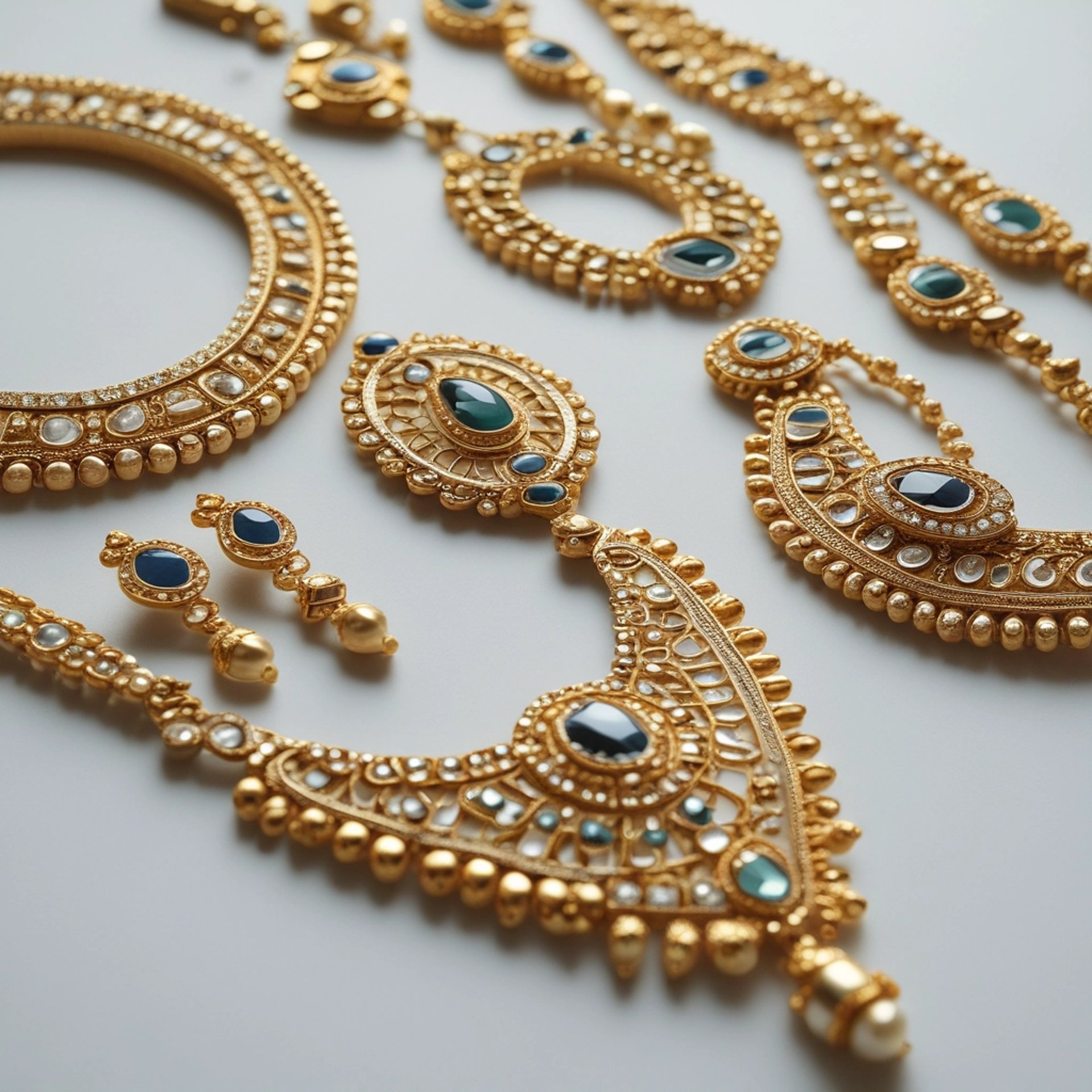Exclusive discounts on traditional jewellery today! Get 5 % off on all online orders by using coupon JWONLINE5

A Journey Through Kundan Jewelry: Art, History, and Tradition in Indian Heritage
Kundan jewelry, with its intricate artistry and timeless elegance, stands as a testament to India's rich cultural heritage and artistic sophistication. This traditional form of jewelry has a fascinating history, echoing the tales of royal courts and the exquisite craftsmanship that went hand in hand with the glory of Indian dynasties. In this blog, we will delve into the origins of Kundan art, its historical significance, and the broader context of traditional Indian jewelry, exploring its evolution through the centuries.
2/5/20253 min read


## The Origins of Kundan Art
### Ancient Beginnings
The term "Kundan" derives from the Hindi word "kundan," meaning highly refined gold. The technique originated in the royal courts of Rajasthan, particularly among the Mughal emperors, around the 16th century. Its inception can be traced back to artisans who specialized in jewel crafting, focused on encapsulating the radiant beauty of gemstones.
Kundan's popularity soared, woven into the culture and fashion of the time, often adorning royal brides on their wedding day or serving as heirlooms passed down through generations. The craftsmanship featured in Kundan pieces showcased intricate motifs, vegetal patterns, and traditional designs influenced by Persian art, reflecting the grandeur of the period.
## Understanding Kundan Jewelry
### Characteristics of Kundan Jewelry
Kundan jewelry is characterized by:
1. Layered Gold Settings: The stones are set into a base made of pure gold and are generally layered to achieve a polished and three-dimensional effect.
2. Colored Gemstones: Kundan employs a variety of gemstones including diamonds, emeralds, rubies, sapphires, and semi-precious stones.
3. Meena Work: Often, Kundan pieces are adorned with Meena (enamel) work, which can add colorful patterns on the gold surface, enhancing the beauty of the jewelry.
4. Heavy yet Comfortable: Kundan jewelry pieces can be heavy due to the quality of gold and the quantity of stones used, but they are fashioned to be surprisingly comfortable when worn.
### Types of Kundan Jewelry
Kundan jewelry encompasses a wide range of adornments, including:
- Necklaces and Earrings: Often the centerpiece of traditional attire, designed to showcase the artistry and skill of the craftsman.
- Bangles: These intricately designed pieces often resonate with tradition and are worn on festive occasions.
- Rings and Maang Tikka: Regarded as essential in bridal attire and worn to enhance beauty and status.
- Haar and Pasa: These headpieces and side necklaces from Rajasthan showcase the richness of Kundan artistry.
## History of Indian Traditional Jewelry
### The Cultural Significance of Jewelry
Jewelry in India is more than mere adornment; it embodies societal values, personal identity, and artistic expression. From age-old temples to lavish weddings, jewelry serves as a symbol of prosperity, power, and cultural heritage, often worn to signify various life stages and ceremonies.
### Evolution Through the Ages
India's rich history reflects the evolution of its jewelry styles, including:
- Indus Valley Civilization: The earliest forms of jewelry adorned with beads, shells, and simple metalwork can be traced back over 5,000 years.
- Vedic Period: During this period, jewelry became more elaborate with gold and silver items, as well as gemstones emerging in artistry.
- Buddhist Influence: The introduction of silver and gold coins and ornate pieces with intricate designs influenced jewelry craftsmanship.
- Colonial Era: The European influence introduced new designs, while Indian craftsmanship evolved to reflect blended styles.
- Contemporary Era: Today's jewelry collections continue to celebrate traditional designs while integrating modern aesthetics and techniques.
## The Craftsmanship Behind Kundan Jewelry
Creating Kundan jewelry involves several meticulous steps:
1. Designing: Artisans sketch intricate designs, often inspired by nature or cultural motifs.
2. Preparing the Base: The base is fashioned from gold, typically using 22 to 24 karat gold.
3. Stone Setting: Stones are laid into the frame, pushed carefully into bezels made from the base metal.
4. Finishing Touches: Once the stones are set and polished, artisans apply Meena work, enhancing their vibrancy.
5. Final Polishing: A thorough polishing process ensures the jewelry shines and retains its beauty.
## The Resurgence of Kundan Jewelry
In recent years, Kundan jewelry has seen a revival, both among fashion enthusiasts and traditionalists. The rise of bridal jewelry trends and the appreciation for ethnic wear have propelled the demand for Kundan pieces in modern wardrobes. Designers have begun incorporating Kundan elements into contemporary jewelry, making them accessible for all occasions. The fusion of traditional Kundan designs with modern aesthetics is a testament to its timeless nature.
## Conclusion
Kundan jewelry stands as a crown jewel in the narrative of Indian artistry, embodying centuries of tradition, skill, and cultural richness. While reflecting individual identity and societal values, it transcends generations, leaving an indelible mark on Indian heritage. As we look back at the centuries-long journey of Kundan art, we are reminded of the intricate web of history that shapes our present and continues to inspire our future. So whether it is for a grand celebration or a casual outing, embracing Kundan can connect us to the legacy of our ancestors while adorning us in exquisite beauty.
Jewellery for every occasion
Exquisite traditional imitation jewellery for modern women.
Quality
Style
+91-8355927315
© 2025. All rights reserved.
